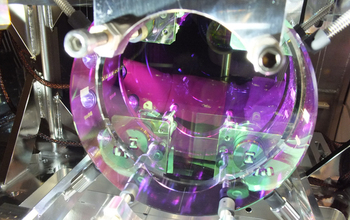
While a sunset would usually have signaled the end of just another day at Al Udeid Air Base, Qatar, for 20 military members the golden hour glow seemed to symbolize the promise of a new beginning.
Enlisted and commissioned Airmen assigned to the 16th Expeditionary Space Control Flight and the 609th Air Operations Center joined the U.S. Space Force during enlistment and oath of office ceremonies at the Silent Sentry compound Sept. 1, 2020.
The ceremonies transferred Space Operations officers and Airmen in core space career fields such as space operations and space systems operations to the United States’ newest military service in more than 70 years. Future ceremonies will induct professionals from common career fields such as acquisition, intelligence, engineering and cyber.
“This group is making history,” said U.S. Air Force Col. Todd Benson, director of Space Forces for U.S. Air Forces Central Command. “Those participating in today’s ceremony are not only joining our nation’s newest service, they are joining this service while deployed in defense of our nation. In other words, they are the first members of the United States Space Force to be deployed in support of combat operations.”
Space across the DoD has traditionally focused on providing support to other domains such as land, maritime and air. The creation of the Space Force allows for a single service to focus on space as its own critical domain.
“For our nation, we must not just be present in space, but we must be a leader in space,” said Benson. “U.S. Space Command and U.S. Space Force will play a critical role in protecting our Nation’s vital interests in space.”
Elevating space in line with the other traditional domains is even more important as the U.S. witnesses other nations preparing to extend conflict into space.
Senior Airman Aron Franks, one of the Airmen who participated in the ceremony, said he is looking forward to watching technology and tactics evolve as the U.S. rises to thwart adversary efforts.
As a 16th ESPCF space systems operations specialist, Franks geo-locates, characterizes and reports sources of electromagnetic interference to U.S. satellite assets.
“It’s rewarding when you get to see how your efforts are being processed or applied to the overall fight, to see our piece of the puzzle,” he said.
Tech. Sgt. Cody Hircock, the superintendent of the 16th ESPCF at AUAB, also became a member of the Space Force. Hircock has spent his 11-and-a-half-year Air Force career in space operations positions.
He said it has been fascinating to watch his career field evolve.
“Back when I joined my first unit in 2009, I actually got to watch them launch our third satellite,” said Hircock. “Now they have ten, so their capabilities have expanded.”
He has been assigned to his current unit for more than a year now. Hircock said he reviews old reports, comparing past performance to what they are able to accomplish now.
“It’s been really impressive to see how much space and the need for space has expanded,” he said.
When it came time to submit his Space Force application, it was an easy decision.
“It’s what I have always known,” said Hircock. “I’ve never had a desire to do anything else and the opportunity to be on the leading edge of a completely new military branch was something I couldn’t pass up.”
Franks, Hircock and other members of the deployed space units will continue to provide space capability to the area of responsibility. While some units have already shifted to the U.S. Space Force, the ceremony the space professionals participated in marked the beginning of transferring personnel units into the Space Force.
“As they depart this ceremony and start to wear the new uniform of our service, I want them wear it with pride,” said Benson. “I could not be more proud to serve alongside them during these historic times.
The United States Space Force’s legacy of combat operations begins today.”
Source: US Space Force
This webpage is made available by SEO Press Release , press release distribution service by Topic News








